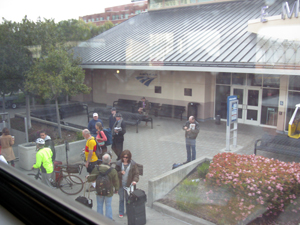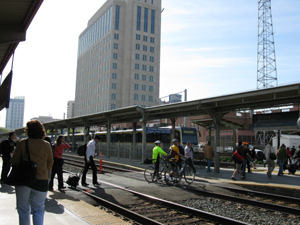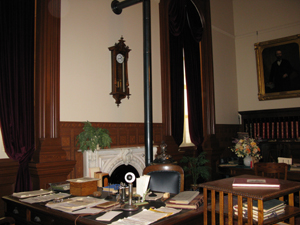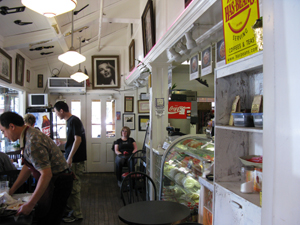 Oakland Amtrak Station
Oakland Amtrak Station
We wanted to ride the train. Several times during our travels we would visit an Amtrak station but we never could
make the schedules work well enough to select a trip. So we would climb back in the truck, fondly remembering the
European trains which seemed to run all the time and go everywhere.
 Oakland Amtrak Station
Oakland Amtrak Station
But here in California there are actually trains which work. We took the Amtrak Capitol Corridor train for a day
in the state capital, Sacramento. We parked at Jack London Square in Oakland and crossed the train tracks to reach
the station. At 7:30 in the morning, a small group of riders had assembled. We bought our tickets and settled in
 Boarding the train
the waiting room for the fifteen-minute wait when a Volunteer approached. She provided additional time tables and
tips based on her own train-riding experience. We learned that we can take Amtrak to Santa Barbara or perhaps even to San
Diego -- places we hadn't considered visiting without a car or a plane trip.
Boarding the train
the waiting room for the fifteen-minute wait when a Volunteer approached. She provided additional time tables and
tips based on her own train-riding experience. We learned that we can take Amtrak to Santa Barbara or perhaps even to San
Diego -- places we hadn't considered visiting without a car or a plane trip.
Soon we were nicely established on the upper level of our coach, wending our way through Oakland and Berkeley and
then along the edge of San Pablo Bay. While the cities look just as grimy from a train window as they do from our
 Sacramento Amtrak Station
truck, it was fun to see the water birds along the edge of the bay. Before long, we were farther out in the country,
passing rice fields and irrigation canals and small town train stations, as well as fields of cows and goats and sheep.
Two hours later we reached Sacramento.
Sacramento Amtrak Station
truck, it was fun to see the water birds along the edge of the bay. Before long, we were farther out in the country,
passing rice fields and irrigation canals and small town train stations, as well as fields of cows and goats and sheep.
Two hours later we reached Sacramento.
The train station in Sacramento is large and busy. We crossed a couple of blocks and passed through the downtown shopping
mall, where we snapped some ceramic panels for our friend Diana's pleasure. In another block we reached the Capitol mall,
a wide boulevard leading to the state Capitol.
 Wall decoration
Both guided and self-guided tours of the Capitol are offered. On this quiet Friday (the legislature was not in session) we opted to guide
ourselves, starting at the top and moving down. We were surprised to find the elevator had an operator: "Of course," she
chuckled. "We are the only ones who can tell the legislators where to get off!"
Wall decoration
Both guided and self-guided tours of the Capitol are offered. On this quiet Friday (the legislature was not in session) we opted to guide
ourselves, starting at the top and moving down. We were surprised to find the elevator had an operator: "Of course," she
chuckled. "We are the only ones who can tell the legislators where to get off!"
After peeking into the Senate and Assembly galleries, and admiring the recently restored and repainted dome, we walked
 The State Capitol
downstairs past offices of politicians and staff. A Clerk of the Assembly saw us in the corridor and invited us into
the gallery itself for a closer look. We noted that each desk has a laptop, where the representative can view the bills
under discussion, or record his/her vote. A special exhibit commemorated Arthur Ohnimus, who served 37 years as Chief Clerk.
The State Capitol
downstairs past offices of politicians and staff. A Clerk of the Assembly saw us in the corridor and invited us into
the gallery itself for a closer look. We noted that each desk has a laptop, where the representative can view the bills
under discussion, or record his/her vote. A special exhibit commemorated Arthur Ohnimus, who served 37 years as Chief Clerk.
On the same floor, we visited several rooms preserved with equipment and decorations from a century earlier. In addition
to the Treasurer's Offices, there are several rooms relating to the Governor and his work. Governor Pardee was in office
 1906 Governor's office
at the time of the 1906 earthquake. A volunteer docent invited us into his office for a look at the furniture and papers,
which, laid out on several desks, describe the items he had been reading when he got the news of the earthquake.
1906 Governor's office
at the time of the 1906 earthquake. A volunteer docent invited us into his office for a look at the furniture and papers,
which, laid out on several desks, describe the items he had been reading when he got the news of the earthquake.
Leaving the Capitol, we strolled through the shopping mall to Old Sacramento where we hoped to find lunch. An elementary school orchestra and chorus were preparing for a mid-day concert, to the delight of parents
and small siblings, which brought an atmosphere of cheerful excitement to the area.
 The children's orchestra
The children's orchestra
Old Sacramento, a four-block collection of Gold Rush-era buildings, is beautifully situated, on the river and an easy walk from the Capitol. It's filled with dozens of tourist shops and restaurants, but there's still a lot of renovation and restoration to be done on the buildings, and a number of empty spaces that need to be filled. More money, please, Sacramento developers!
Unexpectedly we found a tiny cafe serving tasty Indonesian food; Judging from the decor (musical notes and Hollywood stars), the cafe has gone through several different owners and themes. But the shrimp chips and spices were definitely Indonesian - hot and aromatic.
 Our Indonesian cafe
Our final stop was the Railroad Museum, one of California's State Parks. The several trains on display are highly polished
and set out for visitors to climb up and look inside, or -- in the case of a Gold Rush period private coach, peer through
the windows. Separate exhibits concentrate on historical topics, such as the employment of women and the building of the
Transcontinental railroad.
Our Indonesian cafe
Our final stop was the Railroad Museum, one of California's State Parks. The several trains on display are highly polished
and set out for visitors to climb up and look inside, or -- in the case of a Gold Rush period private coach, peer through
the windows. Separate exhibits concentrate on historical topics, such as the employment of women and the building of the
Transcontinental railroad.
Our legs were getting tired, so we left the Railroad Museum and headed back
to the train station, catching a somewhat earlier train than we had anticipated. On the return trip we enjoyed a chat with  Old Sacramento street
a fellow passenger - masseuse cum mountain biker - on her way from Nevada City to a software company party in Berkeley.
Old Sacramento street
a fellow passenger - masseuse cum mountain biker - on her way from Nevada City to a software company party in Berkeley.
Sacramento is the capital of the largest state in the United States - larger than many countries - but it's just a nice city, not a great city. Perhaps all the creative energy flows into the coastal cities - San Diego, Los Angeles, Santa Barbara, and San Francisco are great tourist attractions; even San Jose, Monterey, Santa Cruz, and Malibu seem better for sightseeing. Perhaps it's the glut of 1950's-era government office buildings, or the frequently unoccupied downtown stores. We understand from others that the suburbs are everything, and we have relatives who live high above the city in a mountainside community. Perhaps the high price of gas will lead to a Sacramento renaissance, with gentrification and downtown living for yuppies and lobbyists. But it hasn't happened yet.